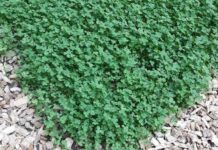
Just as each state in the U.S. has its official bird or flower, shamrocks have come to be the symbol of Ireland. According to legend, St. Patrick, the patron saint of Ireland, used the three-leaves of the shamrock to explain the Holy Trinity of Father, Son, and Holy Ghost in the fourth century A.D.
But what exactly is a shamrock? The word itself comes from the Gaelic seamrog, or “little clover,” and was used as early as the 1500s. So it’s a clover, yes, but which one? There are actually about 300 species in the clover genus Trifolium, or trefoil, and according to botanists, no one throughout history has ever definitively determined the exact plant the shamrock is meant to be. It is, essentially, a man made creation. “The ‘shamrock’ is a mythical plant, a symbol, something that exists as an idea, shape and color rather than a scientific species,” states an article in Smithsonian magazine, “No One Really Knows What a Shamrock Is,” by Bess Lovejoy (March 16, 2015).
Throughout history, botanists have put forth many theories from wood sorrel (Oxalis acetosella), to yellow clover (Trifolium minus), white clover (Trifolum repens), and black medic (Medicago lupulina). According to the Smithsonian, in the late 18oos, amateur botanist Nathaniel Colgan “asked correspondents in 11 Irish counties to collect, around the time of St. Patrick’s Day, samples of shamrocks they considered to be the real deal.” He then repeated the study the following year. Out of a total of 35 plants in the second year, 19 were white clover, 12 yellow clover, two red clover, and two black medick, reports the magazine.
As recently as 1988, E. Charles Nelson, then horticultural taxonomist in Ireland’s National Botanic Gardens, decided to repeat Colgan’s study. Of the 243 samples, 46% were yellow clover, 35% white clover, 7% black medic, 5% wood sorrel, and 4% red clover, says Smithsonian. Eventually Ireland’s Department of Agriculture picked the most popular species, yellow clover, as “official” for export.

These days, however, you’re likely to find oxalis varieties, particularly False Shamrock (Oxalis regnellii) for sale around St. Patrick’s Day in the U.S. as “shamrocks” since they make great year-round houseplants. They have heart-shaped leaves instead of clover’s oval-shaped. For exotic varieties that also look great in outdoor planters, try purple shamrock (Oxalis triangularis) or Lucky Leaf (Oxalis tetraphylla).
As a final thought, let’s not forget the power of clover in lawns. As members of the legume family, they do an important job of converting nitrogen to fertilizer and were included in seed mixes up until the 1950s, though they later came to be viewed as weeds. Today, as homeowners become more aware of chemical usage, clover is making a bit of a comeback in some areas. If a client is willing, overseeding white clover into an existing lawn can naturally add nutrients to the soil.











![[VIDEO] Dickies®: Discover Workwear That’s Anything But Uniform](https://turfmagazine.com/wp-content/uploads/2023/06/1647663814-4b1a2a7742790a9b1e97a3b963477850192e1d6a9dfba9b07214a77bae25d6e3-d-218x150.jpg)






























![[VIDEO] Dickies®: Discover Workwear That’s Anything But Uniform](https://turfmagazine.com/wp-content/uploads/2023/06/1647663814-4b1a2a7742790a9b1e97a3b963477850192e1d6a9dfba9b07214a77bae25d6e3-d-324x160.jpg)